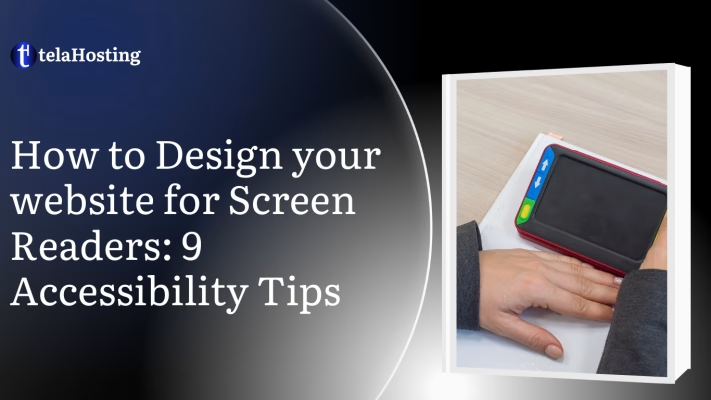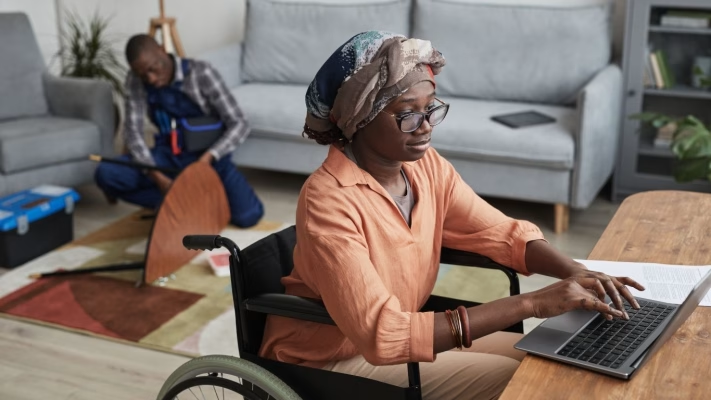
Screen readers play a crucial role in making digital content accessible to visually impaired users. These assistive tools convert on-screen text into speech or braille, allowing users to navigate websites without relying on sight.
In today’s digital world, accessibility is a must, not just a feature. Every website or application should be built to serve all users, including those who rely on screen readers due to visual impairments. Imagine trying to browse the internet without seeing the screen, how would you navigate? That’s where screen readers come in.
At telaHosting, we believe that a truly inclusive internet is one where everyone has equal access to information, services, and digital experiences. In this guide, we’ll break down practical, easy-to-implement tips to make your website more accessible for screen reader users, ensuring your design is user-friendly, professional, and meets global accessibility standards like WCAG (Web Content Accessibility Guidelines).
Understand How Screen Readers Work
Before making a website accessible, it’s important to first understand how screen readers function. Screen readers are assistive software programs that convert text, images, and website elements into speech or braille output. This allows visually impaired users to hear the content or feel it in braille format.
How Do Screen Readers Navigate Websites?

Unlike sighted users, who scan web pages visually, screen reader users navigate using their keyboard and specific commands:
- Text Reading: Reads the content line by line, word by word, or character by character.
- Element Recognition: Identifies headings, links, buttons, and images.
- Keyboard Navigation: Uses keys like Tab, Arrow keys, and Enter to move through the site.
- Search Function: Allows users to find specific words, headings, or elements on a page.
Popular Screen Readers
If you want to test how your website sounds to a visually impaired user, try using a screen reader yourself. Some of the most common ones include:
- NVDA (Windows): Free and widely used.
- AWS (Windows): Paid but powerful and feature-rich.
- VoiceOver (Mac & iOS): Built into Apple devices.
- TalkBack (Android): Google’s built-in screen reader.
- Try navigating your website using only a screen reader to understand how well it works.
Designing for Screen Readers: 10 Accessibility Tips
-
Use Semantic HTML for Proper Structure
A screen reader depends on a website’s HTML code to grasp the layout of the page. If the structure is jumbled or incorrect, the screen reader might read things out of order or miss out on important content altogether.
Semantic HTML is all about using the right HTML tags for different types of content, allowing screen readers to identify and announce elements accurately.
Best Practices for HTML Structure:
- Use Proper Headings: Instead of just bolding text for headings, make sure to use the appropriate <h1> to <h6> tags.
- Keep a Logical Flow: Headings should follow a sensible order. Avoid jumping from <h1> to <h4> without the <h2> and <h3> in between.
- Use <p> Tags for Paragraphs: Don’t create paragraphs using line breaks <br>.
- Use Lists for Grouped Content: For bullet points, opt for <ul> (unordered list) and <li> (list item) instead of just slapping on dashes.
Example of Good HTML Structure:
A well-structured website ensures that screen readers present content in the correct order, making it easier for users to comprehend.
-
Write Descriptive Alternative Text (Alt Text) for Images
Images are vital for visual appeal, but for users with visual impairments, they’re only useful if described properly. That’s why adding alternative text (alt text) is so important.
Alt text is a written description of an image that a screen reader vocalizes to explain what the image depicts. So, for Alt Text it must:
- Be clear and concise: Keep it brief but informative.
- Describe what’s important: Focus on the main content or purpose of the image.
- Skip decorative images: If an image is just for design and has no meaning, use alt=”” to tell screen readers to ignore it.
Example of Good and Bad Alt Text:
- Bad Alt Text: “Picture of a website”
- Good Alt Text: “telaHosting homepage with hosting plans starting at ₦2,500/month”
By using effective alt text, visually impaired users can still understand what an image is about.
-
Make Links and Buttons Clear & Meaningful
For many users who rely on screen readers, navigating websites often means jumping from link to link. If your links are just labeled “Click Here” or “Read More,” they don’t give enough context about where they actually lead. for Links & Buttons:
- Use descriptive text: Instead of saying “Click Here,” try something like “Learn more about our hosting plans”
- Don’t rely solely on color to highlight links: Ensure that links are easily distinguishable for users with color blindness.
- Make sure buttons have clear labels: Each button should clearly convey its purpose.
For example:
Bad Link: <a href=”pricing.html”>Click here</a>
Good Link: <a href=”pricing.html”>See TelaHosting’s Pricing Plans</a>
With meaningful link text, users with screen readers can quickly grasp where each link will take them.
-
Ensure Keyboard Accessibility
Many visually impaired users navigate the web without a mouse, relying solely on their keyboard. If your website is designed for mouse use only, it can be completely inaccessible to them. It is important you make your website keyboard-friendly by:
- Checking that everything can be accessed using just the keyboard.
- Making sure focus indicators (the outlines that show which element is active) are visible.
- Avoiding keyboard traps, where users can get stuck and can’t move forward.
How to Test Keyboard Accessibility?
- Use the Tab key to cycle through links, buttons, and form fields.
- Use Shift + Tab to go back.
- Press Enter or Space to activate buttons.
If you find you can’t reach a section or get stuck, it’s a sign that something needs to be fixed!
-
Use ARIA Roles for Enhanced Accessibility
Even if your HTML is well-structured, some interactive elements, like dropdown menus, modals, or custom buttons, might not be fully recognized by screen readers. That’s where ARIA (Accessible Rich Internet Applications) roles come into play.
What is ARIA and Why is it Important?
ARIA consists of a set of special attributes designed to help screen readers grasp how certain elements work. It adds extra context for dynamic or complex elements that plain HTML might not adequately describe.
Examples of ARIA Roles & Their Uses:
- role=”navigation”: This helps screen readers recognize a section as a navigation bar.
- role=”button”: This indicates to screen readers that an element acts like a button.
- aria-live=”polite”: This alerts users when dynamic content changes (like chat messages or error notifications).
- aria-expanded=”true”: This shows whether a dropdown or accordion menu is open or closed.
- aria-label=”Search our site”: This gives additional description for form fields, buttons, and other interactive elements.
Example of ARIA in Action: <button role=”button” aria-label=”Subscribe to our newsletter”>Subscribe</button>
In this example, the aria-label adds extra context, making it clear for screen readers what the button does.
When to Use ARIA (And When Not To)?
Use ARIA when HTML alone doesn’t convey the necessary meaning and avoid using ARIA if HTML elements already have built-in accessibility features (for instance, a <button> element inherently tells a screen reader it’s a button).
By using ARIA correctly, you’ll make your website more understandable and navigable for users who rely on screen readers.
-
Provide Transcripts & Captions for Media
While videos and audio content can be fantastic for engaging users, they can also pose challenges for those who depend on screen readers. Individuals who are blind, deaf, or hard of hearing may find it difficult to access media content without text alternatives.
Why Are Transcripts & Captions Important?
- Transcripts are a game-changer for screen reader users, allowing them to read along with what’s being said in videos or podcasts.
- Captions are essential for those who are deaf or hard of hearing, helping them keep up with the spoken content.
- SEO perks: While search engines can’t “watch” videos, they can certainly read transcripts, which can boost your search rankings.
How to Make Your Media Accessible?
- Add captions to your videos: Platforms like YouTube and Vimeo make it easy to upload or even auto-generate captions.
- Provide a text transcript : Always include a written version of the audio for podcasts or interviews.
- Use accessible media players: Make sure your video/audio player supports keyboard navigation for ease of use.
Example of a Transcript for a Video: “Welcome to telaHosting! We offer fast, secure, and reliable web hosting in Nigeria. Our services include domain registration, cloud hosting, and 24/7 customer support.”
By incorporating transcripts and captions, you’re making sure that everyone can enjoy your content, no matter their abilities.
-
Test Regularly for Accessibility Compliance
Even when you stick to best practices, things can slip through the cracks. That’s why it’s crucial to conduct regular accessibility testing. You can do regular testing by:
- Using Screen Readers: Test your site with tools like NVDA, JAWS, or VoiceOver to see how it performs.
- Checking Keyboard Navigation: Can you navigate everything without using a mouse?
- Running an Accessibility Audit: Utilize automated tools to scan for common issues.
- Geting Feedback from Real Users: If you can, test with visually impaired individuals to understand how well your site works for them.
Free Accessibility Testing Tools
- WAVE (Web Accessibility Evaluation Tool) : This tool checks for errors in HTML structure and contrast issues.
- Lighthouse (Built into Chrome Developer Tools): It provides accessibility scores and tips for improvement.
- axe DevTools (Browser Extension): This highlights accessibility problems in real time.
Make it a habit to run these tests before and after every major website update to ensure ongoing accessibility compliance.
-
Don’t Rely Solely on Color to Communicate Meaning
A lot of websites lean on color alone to emphasize key information (like using red for errors and green for success messages). However, this can create challenges for users who are colorblind or have visual impairments. You can design for users with low vision or color blindness by:
- Combine text with color: Instead of just changing the color, add labels or icons for clarity.
- Ensure strong contrast: Use bold contrasts between text and background to enhance readability.
- Offer alternative indicators: Use underlines for links rather than relying solely on color changes.
Example of an Accessible Error Message:
Bad: “Your password is incorrect (shown in red only).”
Good: “❌ Error: Your password is incorrect. Please try again.”
By incorporating alternative visual cues, you help users grasp your content even if they can’t perceive colors accurately.
-
Make Forms User-Friendly and Accessible
Forms are essential for any website, but they can be a hassle for screen reader users if they’re not designed thoughtfully. So, for accessible forms:
- Always include labels: Use <label> tags instead of just placeholder text within the input field.
- Group related fields: Utilize <fieldset> and <legend> to categorize similar form elements.
- Clarify error messages: Rather than just highlighting fields in red, provide clear text-based error descriptions.
Example of an Accessible Form: <label for=”email”>Email Address:</label>
<input type=”email” id=”email” name=”email” required aria-required=”true”>
<p id=”error-email” aria-live=”assertive”>Please enter a valid email address.</p>
This setup ensures that screen readers can accurately announce required fields and any errors.
Conclusion
Designing for screen readers goes beyond just meeting compliance standards, it’s about crafting a web experience that’s inclusive for everyone. By
implementing these practical accessibility tips, you can make sure that:
- Your website is easy to navigate for visually impaired users.
- Your content is clear and comprehensible.
- Your media, forms, and interactive elements are fully accessible.
At telaHosting, we are committed to helping businesses build accessible, inclusive websites that reach a wider audience. If you need expert web hosting or accessibility-friendly web development in Nigeria, we’ve got you covered!